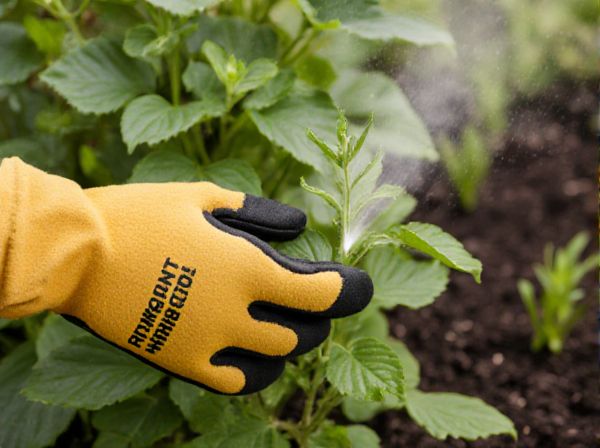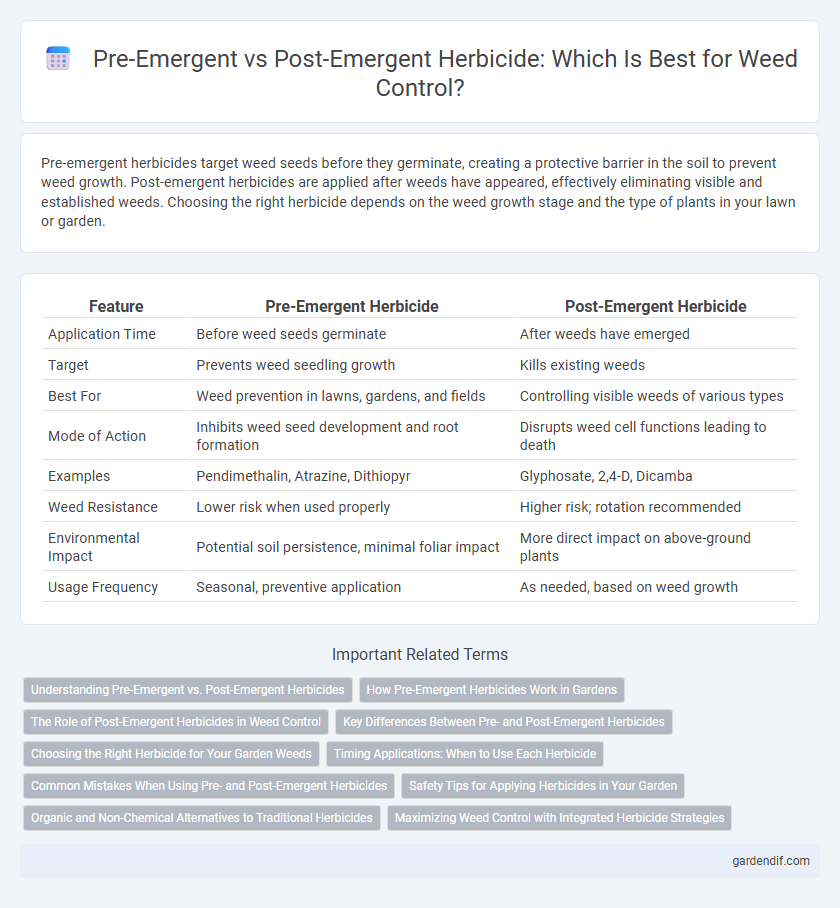
Pre-emergent herbicide vs post-emergent herbicide Illustration
Pre-emergent herbicides target weed seeds before they germinate, creating a protective barrier in the soil to prevent weed growth. Post-emergent herbicides are applied after weeds have appeared, effectively eliminating visible and established weeds. Choosing the right herbicide depends on the weed growth stage and the type of plants in your lawn or garden.
Table of Comparison
| Feature | Pre-Emergent Herbicide | Post-Emergent Herbicide |
|---|---|---|
| Application Time | Before weed seeds germinate | After weeds have emerged |
| Target | Prevents weed seedling growth | Kills existing weeds |
| Best For | Weed prevention in lawns, gardens, and fields | Controlling visible weeds of various types |
| Mode of Action | Inhibits weed seed development and root formation | Disrupts weed cell functions leading to death |
| Examples | Pendimethalin, Atrazine, Dithiopyr | Glyphosate, 2,4-D, Dicamba |
| Weed Resistance | Lower risk when used properly | Higher risk; rotation recommended |
| Environmental Impact | Potential soil persistence, minimal foliar impact | More direct impact on above-ground plants |
| Usage Frequency | Seasonal, preventive application | As needed, based on weed growth |
Understanding Pre-Emergent vs. Post-Emergent Herbicides
Pre-emergent herbicides target weed seeds before they germinate, forming a chemical barrier that prevents weed growth and is most effective when applied early in the season. Post-emergent herbicides kill existing weeds by being absorbed through leaves or stems, making them suitable for controlling visible, established weed populations. Understanding the timing and mode of action is crucial for optimizing weed management strategies and minimizing damage to desirable plants.
How Pre-Emergent Herbicides Work in Gardens
Pre-emergent herbicides create a chemical barrier in the soil that prevents weed seeds from germinating and sprouting, effectively stopping weeds before they emerge. These herbicides target the early stages of weed growth by interfering with root and shoot development. Applying pre-emergent herbicides in gardens before weed seeds begin to germinate ensures optimal control of invasive species like crabgrass and goosegrass.
The Role of Post-Emergent Herbicides in Weed Control
Post-emergent herbicides play a critical role in weed control by targeting actively growing weeds, allowing for precise application after weed emergence. These herbicides disrupt vital physiological processes such as photosynthesis, growth, or protein synthesis, effectively eliminating broadleaf and grassy weeds. Their selective action helps maintain crop health and turf quality while reducing competition for nutrients, water, and light.
Key Differences Between Pre- and Post-Emergent Herbicides
Pre-emergent herbicides target weed seeds or seedlings before they germinate, creating a chemical barrier that prevents weed growth, whereas post-emergent herbicides act on actively growing weeds after they have emerged from the soil. Pre-emergent formulations are typically applied to bare soil or early in the season to control annual grasses and broadleaf weeds, while post-emergents are used for spot treatments or widespread application against established weeds. The timing, mode of action, and the types of weeds controlled are critical factors differentiating the use and effectiveness of pre- and post-emergent herbicides in integrated weed management.
Choosing the Right Herbicide for Your Garden Weeds
Pre-emergent herbicides target weed seeds before they germinate, making them ideal for preventing crabgrass and annual weeds in vegetable gardens and flower beds. Post-emergent herbicides are formulated to kill actively growing weeds such as dandelions and bindweed, providing effective control after weed emergence. Selecting the correct herbicide depends on the weed species, growth stage, and garden plant tolerance to ensure optimal weed management and healthy plant growth.
Timing Applications: When to Use Each Herbicide
Pre-emergent herbicides are applied before weed seeds germinate, typically in early spring or late fall, to prevent weed growth by creating a chemical barrier in the soil. Post-emergent herbicides target actively growing weeds and should be used when weeds are visible and in the early stages of development for maximum effectiveness. Proper timing of these herbicides enhances weed control in lawns, gardens, and agricultural fields by interrupting the weed life cycle at critical growth phases.
Common Mistakes When Using Pre- and Post-Emergent Herbicides
Applying pre-emergent herbicides after weeds have already sprouted significantly reduces their effectiveness, as these products are designed to prevent seed germination rather than kill existing plants. Overusing post-emergent herbicides can lead to herbicide resistance, especially in hard-to-control weeds like Palmer amaranth and giant ragweed, making future treatments less effective. Failing to follow label instructions for timing, dosage, and application conditions often results in poor weed control and potential damage to desirable plants.
Safety Tips for Applying Herbicides in Your Garden
Pre-emergent herbicides prevent weed seeds from germinating, requiring careful timing to avoid harming desirable plants, while post-emergent herbicides target actively growing weeds and demand precision to minimize damage to crops. Always wear protective gloves, masks, and eyewear to reduce exposure risks when handling chemicals like glyphosate or atrazine. Follow label instructions meticulously, avoid application on windy days, and keep children and pets away from treated areas until fully dry to ensure garden safety.
Organic and Non-Chemical Alternatives to Traditional Herbicides
Pre-emergent herbicides prevent weed seeds from germinating by creating a chemical barrier in the soil, while post-emergent herbicides target actively growing weeds after they emerge. Organic alternatives such as corn gluten meal act as natural pre-emergent herbicides by inhibiting seed development without synthetic chemicals. Non-chemical options like mulching, manual weeding, and flame weeding effectively control weeds by physically removing or suppressing growth, promoting sustainable and eco-friendly weed management.
Maximizing Weed Control with Integrated Herbicide Strategies
Pre-emergent herbicides target weed seeds before they germinate, creating a barrier that prevents early weed establishment, while post-emergent herbicides focus on controlling actively growing weeds after they emerge. Combining pre-emergent and post-emergent treatments maximizes weed control by addressing multiple stages of weed growth, reducing resistance development and improving crop health. Integrated herbicide strategies are essential for sustainable weed management, enhancing overall efficacy and minimizing environmental impact.
Pre-emergent herbicide vs post-emergent herbicide Infographic

 gardendif.com
gardendif.com